Imagine being part of a world where your friends, family, or even you, could vanish without a trace, yet no one remembers they ever existed. That’s the eerie and terrifying nature of the False Hydra, a monstrous entity in Dungeons and Dragons that doesn’t just confront your physical senses but messes with your mind. Its powers extend far beyond the typical combat encounter; this creature embodies psychological horror, capable of erasing individuals from existence while making those around them forget they ever lived. Terrifying, right?
Introducing a False Hydra into a D&D campaign is no small feat. It requires a storyteller’s grace, a keen understanding of player psychology, and a true commitment to crafting an unsettling narrative. This is because the horror it brings isn’t built on jump scares or grotesque images. It’s about the slow, creeping realization that something deeply wrong is occurring—a kind of existential dread that grows more unsettling the more you think about it.
For Dungeon Masters looking to weave this sinister being into their campaigns, careful planning is crucial. The False Hydra is an entity that thrives on nudging reality out of alignment. It’s not just about battling tentacles and monstrous songs; it’s about the paranoia that builds when players find gaps in their known world. The missing details, the people they can’t quite recall, the memories that seem… off.
Incorporating a False Hydra is equivalent to crafting a psychological thriller rather than a traditional monster hunt. The creature bends reality in ways that can twist the campaign itself, planting seeds of doubt and mistrust among players. It’s not just another monster to defeat; it’s a narrative device that can redefine the fabric of a game world.
And here’s the thing: players may not even realize they’re under its influence until the veil finally lifts—and by that point, the damage may be profound. This creature has the potential to transform a straightforward adventure into an unforgettable tale of horror and emotional turmoil. Players will find themselves questioning their own perceptions and challenging the reliability of their fellow party members.
So, why dive into this chaotic abyss? Because the False Hydra offers a unique opportunity to explore deep psychological themes and player dynamics. It’s a challenge, yes, but one that can result in a satisfying, spine-chilling experience that lingers long after the campaign ends. A False Hydra campaign isn’t for the faint-hearted, but it rewards those who are willing to delve into its complexities with a tale that’s as haunting as it is compelling.
Try my AI Tabletop RPG generators...and an extensive library of content!
In the chapters ahead, we’ll explore the intricacies of the False Hydra, from its terrifying abilities to its impact on player perception. Each section will unravel the multiple layers that make this monster a masterpiece of psychological storytelling. Prepare yourself—once you understand the depths of its influence, you’ll see why the False Hydra is one of the most horrifying creatures in the D&D universe.
- Understanding the False Hydra: What Makes It So Terrifying?
- The Unique Horror of the False Hydra’s Abilities
- False Hydra vs. Traditional Horror Monsters
- Setting Up a False Hydra Mystery in Your Campaign
- Foreshadowing the False Hydra’s Influence
- Designing a False Hydra-Infested Town
- The Slow Unraveling: When Players Start to Remember
- Running a False Hydra Encounter: Horror in Action
- Designing a False Hydra Lair
- Combat with the False Hydra: Making It More Than Just a Fight
- Aftermath: How to Handle the Psychological Fallout
- Alternative Endings: What If the False Hydra Wins?
- Final Thoughts on Using the False Hydra in a D&D Campaign
Understanding the False Hydra: What Makes It So Terrifying?
The False Hydra isn’t just another monster lurking in the dark corners of the D&D universe. It’s a creature born out of a nightmare, a being that distorts reality with its very presence. But what exactly makes it so terrifying? To truly grasp the horror it brings, we must first dive into its origins, lore, and unique abilities.
Legends whisper that the False Hydra spawns from deep underground, rising to the surface to feed on the memories of the living. Unlike other monsters, it doesn’t simply devour flesh and bone—it consumes identity itself. Picture yourself in a village where people vanish, their existence scrubbed from the memories of their loved ones. It’s as if they were never there, their absence a gnawing void only recognized by those who dare to remember.
This creature’s malevolent magic lies in its song, a haunting melody that ensnares the minds of those who hear it. The song erases memories of the Hydra’s victims, leaving behind a distorted reality. Imagine waking up and feeling that something or someone is missing, yet unable to pinpoint what or who. That’s the power of the False Hydra—subtle, insidious, and profoundly disturbing.
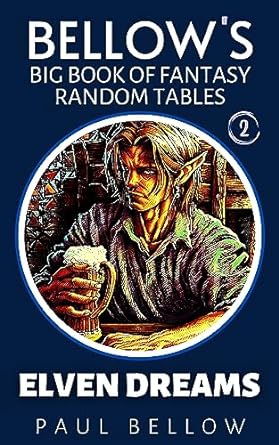
Fantasy RPG AI Generators with ChatGPT+
Make life as a Game Master easier.... If you play Dungeon & Dragons, Pathfinder, or other fantasy tabletop role-playing games, check out my DND character backstory generator and other fine AI RPG tools at LitRPG Adventures Workshop today.
Unlike a traditional monster, the False Hydra isn’t a threat you can simply confront with swords and spells. It operates on a different level—attacking the very perception of reality. It makes the players question the world around them, doubt their own senses, and even mistrust their companions. It’s not just a battle of strength, but a psychological warfare, making it more of a narrative force than a mere boss fight.
As it lurks in the shadows, the Hydra subtly alters the environment. It changes town layouts and replaces lost NPCs with false memories, manipulating reality to suit its needs. The more it feeds, the more it grows, and with it, the song spreads further, erasing more memories. Unlike any other creature, it creates a surreal blend of horror and confusion, making players doubt their notes, memories, and even their own identities.
Incorporating the False Hydra into a campaign isn’t just about adding another monster. It’s about crafting an experience that challenges players on a psychological level. The horror doesn’t stem from its appearance, but from the chilling realization that reality itself is unstable. It’s less about a direct confrontation and more about surviving the creeping dread of existential horror.
To sum it up, the False Hydra is a master of psychological terror. It embodies a different kind of fear—a slow, creeping dread that builds as players piece together the mystery of vanishing people and forgotten memories. Its eerie song and reality-bending abilities make it a unique adversary that transforms a D&D campaign into a dark psychological thriller.

The Unique Horror of the False Hydra’s Abilities
The true horror of the False Hydra lies in its unique abilities, which extend beyond the physical and into the metaphysical, creating an experience that’s as unsettling as it is memorable. At the heart of its power is its song—a haunting melody that erases the memories of its victims. This ability alone sets it apart from other D&D monsters, marking it as a creature of psychological manipulation rather than brute force.
The Hydra’s song is a soft, eerie tune that seeps into the mind, subtly eradicating the existence of those it consumes. Imagine a melody so insidious that it wipes away the very notion of a person, leaving no trace behind, except the nagging feeling that something is amiss. This isn’t just a monster that hides in the darkness—it’s one that alters the mind, creating a living nightmare.
Another defining trait of the False Hydra is its capacity to make entire people vanish from existence without anyone noticing. When it claims a victim, their place in the world is filled with false memories, ensuring no void is left behind. Picture a town where everyone remembers an imaginary friend or relative instead of the person who’s truly missing. This reality-warping ability ensures no one recalls those lost to the Hydra, maintaining a terrifying status quo.
How the False Hydra Manipulates Reality
- Fake Memories: Replaces erased individuals with fabricated memories, so no one notices their absence.
- Altered Town Layouts: Changes the town’s geography, making familiar streets lead nowhere.
- Unreliable Notes: Ensures written records contradict what players remember.
- Imaginary NPCs: Introduces new, false NPCs to fill the gaps of missing people.
- Confusing Directions: Makes navigation difficult, as paths change subtly.
- Mind Blocks: Prevents characters from recalling certain details or actions.
- Mental Gaps: Creates unexplainable blanks in players’ memories.
- Faux History: Alters historical events to fit its narrative.
- Distorted Perceptions: Causes players and NPCs to see things that aren’t there.
- False Echoes: Generates sounds or voices that lead players astray.
- Visual Illusions: Displays mirages or shifting shadows to disorient.
- Conflicted Remembrances: Encourages conflicting accounts of the same incidents.
- Emotional Manipulation: Alters NPCs’ emotions, causing irrational behavior.
- Disorientation Spells: Casts confounding illusions over large areas.
- Temporal Shifts: Warps time perception, causing events to appear out of order.
- False Friendships: Forges new relationships in the players’ minds.
- Nonexistent Possessions: Fabricates memories of owning items that never existed.
- Imagined Events: Plants memories of events that never took place.
These methods of manipulation are what make the False Hydra a truly fearsome opponent. It’s not about a shocking reveal, but a slow-burn horror that gnaws at the corners of the mind. It’s a creature that embodies subtlety, crafting an atmosphere of distrust and doubt. As players begin to discern the inconsistencies in their world, the reality of the Hydra’s influence becomes increasingly apparent.
In conclusion, the mechanics of the False Hydra create an experience beyond a simple battle. It’s a journey into the unknown, a dance with an adversary who thrives on perceptions and realities. This makes it an unpredictable and profoundly disturbing presence, one that transforms the campaign into an intricate puzzle of identity and remembrance. Through the Hydra, DMs can cultivate a horror story that unfolds not in a sudden jolt, but in the creeping dread of existential uncertainty.
False Hydra vs. Traditional Horror Monsters
When discussing horror in Dungeons and Dragons, creatures like mind flayers, vampires, and ghosts often come to mind. These monsters bring their own brand of terror, but the False Hydra stands apart, offering a different kind of horror—one rooted in existential dread rather than direct fear. It doesn’t just lurk in the shadows; it changes the very fabric of reality, leaving a trail of forgotten identities and altered memories.
Mind flayers, for example, are known for their intellect and psychic abilities, presenting a terrifying blend of cerebral horror and physical threat. Meanwhile, vampires exude a classic, gothic horror with their bloodlust and immortality. Ghosts bring a supernatural element, with hauntings and unresolved pasts leading to chilling D&D encounters. But the Hydra is different—it doesn’t rely on these traditional scare tactics. Instead, the Hydra’s horror comes from its sheer resilience and overwhelming presence in battle, regenerating heads as quickly as they are severed. This relentless regeneration forces players into a desperate struggle, demanding strategy over brute force. It’s a creature that might even have adventurers rethinking the mind flayer as a preferable foe—at least one that stays dead when defeated.

Fantasy RPG AI Generators with ChatGPT+
Make life as a Game Master easier.... If you play Dungeon & Dragons, Pathfinder, or other fantasy tabletop role-playing games, check out my DND character backstory generator and other fine AI RPG tools at LitRPG Adventures Workshop today.
The True Horror of the False Hydra lies in its subtleties. Unlike a mind flayer, which attacks thoughts and memories directly, the Hydra makes slight, almost imperceptible shifts in reality. It warps perceptions in a slow, deliberate manner, creating unease and paranoia that build over time. This makes it more of a psychological threat than a physical one, shifting the focus from combat prowess to mental resilience.
Comparison Table: False Hydra vs. Other Horror Creatures
| Creature | Theme | Mechanics | Impact on Players |
|---|---|---|---|
| False Hydra | Existential Dread | Memory Erasure, Reality Warping | Paranoia, Identity Crisis |
| Mind Flayer | Psychic Horror | Mental Domination, Thought Control | Fear of Loss of Control |
| Vampire | Gothic Horror | Bloodlust, Immortality | Fear of Predation, Corruption |
| Ghost | Supernatural Horror | Hauntings, Unfinished Business | Unease, Fear of the Unknown |
| Lich | Undead Horror | Necromancy, Dark Magic | Fear of Death, Power Corruption |
| Werewolf | Transformation Horror | Lycanthropy, Rage | Fear of Loss of Humanity |
| Shadow | Darkness Manifested | Strength Drain, Shadow Stealth | Fear of the Dark, Powerlessness |
| Banshee | Wailing Spirit | Death Wail, Undead Abilities | Despair, Acceptance of Fate |
| Wraith | Vengeful Spirit | Life Drain, Intangibility | Fear of Retribution, Helplessness |
| Zombie | Undead Threat | Horde Combat, Disease Spread | Fear of Overwhelming Odds |
| Demon | Chaotic Evil | Infernal Powers, Corruption | Fear of Corruption, Moral Crisis |
| Mummy | Ancient Curse | Curse Abilities, Undead Strength | Fear of Ancient Forces, Fate |
The Hydra’s real terror is less about direct confrontation and more about the gradual erosion of certainty. It’s about feeling something is missing, a wrongness in the world that’s hard to pin down. Players must rely on their wits and intuition to uncover the truth, making the encounter more about unraveling a mystery than defeating a foe.
Due to its unique nature, the False Hydra fits best within psychological horror campaigns rather than traditional dungeon crawls. It requires a nuanced approach, where atmosphere and story take precedence over combat mechanics. When executed well, the False Hydra can transform a standard D&D session into an experience that lingers in players’ minds, a haunting reminder of how fragile reality can be.
Through its unique blend of horror, uncertainty, and psychological warfare, the False Hydra stands as a testament to the power of storytelling in creating memorable and chilling D&D encounters. Unlike traditional horror monsters that rely on overt dread, the False Hydra provides a slower, more insidious type of terror—one that challenges players not with what lurks in the shadows, but with what their own minds might betray. Embracing its complexity offers Dungeon Masters a chance to push narrative boundaries and explore unexplored depths of fear and doubt, crafting a campaign that is both haunting and unforgettable.
Setting Up a False Hydra Mystery in Your Campaign
For Dungeon Masters keen on incorporating the False Hydra into their campaigns, ingenuity and subtlety are the keys to success. The trick lies in introducing the creature without immediately revealing its nefarious presence. Players should be drawn into a web of intrigue and growing paranoia, as the Hydra’s influence seeps into their perceptions and stretches the very fabric of reality. The art of gradual terror demands patience and a flair for storytelling.
The essence of a False Hydra’s horror comes from the environment it controls. A town under its influence becomes a stage for mystery—a place where reality is slightly off-kilter and details never quite fit together. Initial encounters should be mundane, yet tinged with inexplicable oddities. Missing people, notes that defy logic, and NPCs reacting strangely form the first threads of suspicion that lead players into the Hydra’s insidious grip.
A meticulously crafted False Hydra mystery thrives on tension. It grows more palpable with every day the players spend unraveling it, moving past first impressions to uncover secrets hidden beneath layers of manipulated reality. Clues should be subtle, encouraging players to trust their instincts and piece together an ever-evolving puzzle. This is not a race; it’s a dance of storytelling where every step is as important as the last.
Discovering the Hydra’s presence involves a series of small revelations, each one deepening the mystery. By leaving a trail of breadcrumbs through NPC interactions, environmental changes, and player discoveries, Dungeon Masters can craft a rich narrative web. Players will begin to question not only their surroundings but also their perceptions—what is real, and what is the Hydra’s doing?
The gradual steady build-up forms the foundation of a False Hydra campaign. It transforms a typical role-playing session into an exploration of what it means to see reality slip through one’s fingers. As tension mounts, players will become more attuned to the discrepancies in the world, relying on each other to piece together the truth. The Hydra’s influence, once hidden, becomes a looming presence they can no longer ignore.
Try my AI Tabletop RPG generators...and an extensive library of content!
Finally, the strength of a False Hydra mystery lies in its ability to sustain tension over time. It should deliver an unsettling experience that lingers long after the session ends, leaving players questioning what they know about their world. The Hydra’s influence should feel like a caress of shadow, a brush with the unknown that unsettles players through its sheer ambiguity. Such a campaign is not about a quick scare—it’s about creating a lasting, haunting impression.
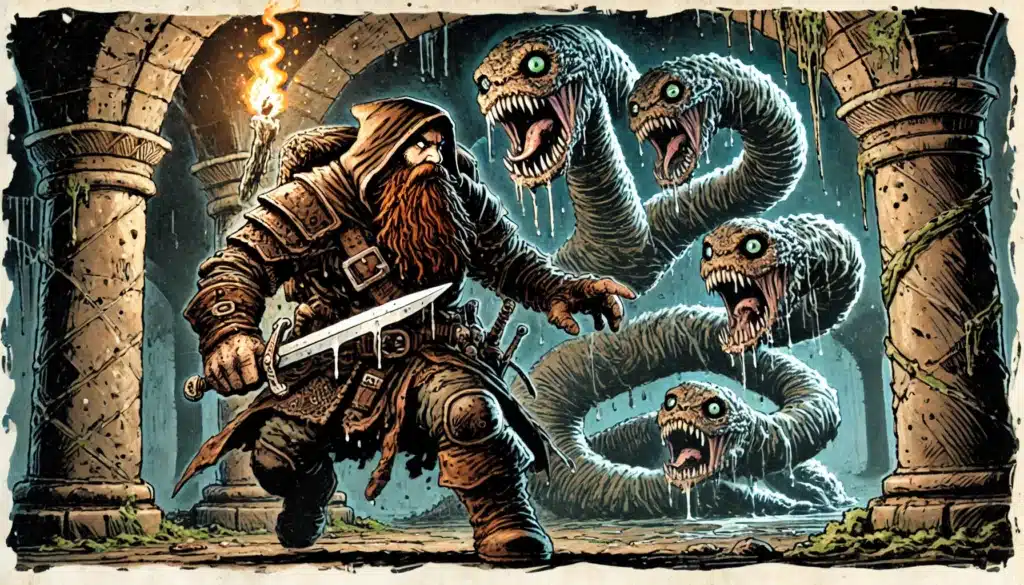
Foreshadowing the False Hydra’s Influence
To effectively foreshadow the False Hydra’s influence, subtlety is your ally. Early warning signs should be almost imperceptible at first, slowly building into an undeniable presence. The key is to introduce elements that make players question the very nature of reality from the onset, setting the tone for the psychological horror to unfold.
Early Warning Signs of the False Hydra
- Missing Persons Notices: Posters of missing people frequently appear, only to be inexplicably removed later.
- Inconsistent Maps: Town maps that players acquire differ slightly from reality.
- Strange NPC Reactions: NPCs exhibit confusion when asked about missing loved ones, deflecting without notice.
- Odd Relics: Players find objects with no apparent owner or history.
- Incoherent Notes: Journals and records contain entries that don’t make sense.
- Fragmented Conversations: NPCs carry on conversations as if players missed part of it.
- Disjointed Memories: Characters occasionally fail to recall shared experiences.
- Daily Routine Changes: The town’s daily rhythm alters subtly, with little explanation.
- Eerie Silences: Places in town fall eerily silent without reason.
- Inexplicable Changes: Buildings or landmarks subtly change locations.
- Subtle Deja Vu: Players experience moments of deja vu, feeling like they’ve been places before under different circumstances.
- Emotional Disconnects: Loved ones seem emotionally distant or oddly detached.
- Ghostly Whispers: Faint echoes of voices or music linger with no source.
- Incorrect News: News of events that didn’t happen or were remembered differently.
- Random Objects Missing: Personal items vanish and reappear without cause.
Such nuances make the false Hydra’s menace more insidious, as players must sift through real and fabricated clues. As they dig deeper, the world they know becomes a tapestry of past and present woven with the threads of illusion, pushing them toward an inevitable confrontation with the truth.
In the realm of psychological horror, subtlety is power. The absence of blatant terror makes these forewarnings far more effective, fueling player paranoia and drawing them deeper into the mystery. The Hydra’s shadow looms larger with each inconsistency, crafting an immersive experience that builds suspense through the weight of its unseen, unsettling presence.
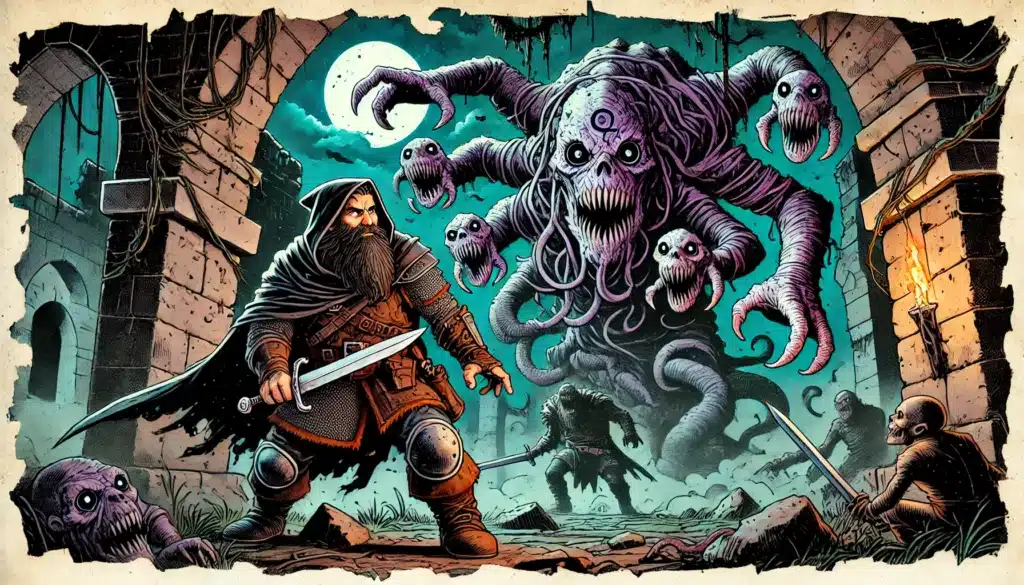
Designing a False Hydra-Infested Town
Creating a town infested by the False Hydra involves more than just setting the scene; it requires crafting an environment rich with atmosphere and layered with unsettling details. The town itself becomes a character in the narrative—a surreal playground that reacts and reshapes itself under the Hydra’s influence, challenging players to separate truth from illusion.
Imagine a village teetering on the edge of obscurity, where every corner and shadow hints at secrets untold. Streets subtly rearrange themselves, landmarks shift positions, and familiar faces become strangers overnight. This is the unsettling magic of a Hydra-infested town, an ever-changing maze that keeps players on their toes, uncertain of what to trust.
Table: Town Features Under the False Hydra’s Influence
| Town Feature | Change Due to False Hydra | Player Perception |
|---|---|---|
| Town Square | Statues seem slightly different | Familiarity breeds discomfort |
| Market Stalls | Vendors sell different wares | Regular items seem out of place |
| Clock Tower | Time appears inconsistent | Appointments go awry |
| Tavern Atmosphere | Patrons act unusually subdued | Conversation lulls |
| Local Church | Symbols mysteriously altered | Spiritual unease |
| Residential Homes | Doors don’t lead to expected | Sense of intrusion |
| Inn Layout | Rooms seem misaligned | Guests feel displaced |
| Schoolhouse | Students missing, unaccounted | Knowledge seems ephemeral |
| Bridge Over River | Shifts to new location | Crossings become treacherous |
| Library Archives | Books rearrange randomly | Seekers find frustration |
This evolving, dynamic setting forces players to question every aspect of their environment. The familiar becomes foreign, and what seemed safe turns unpredictable. As the players explore the town, they will inevitably notice discrepancies, the loose threads of the Hydra’s crafty manipulation.
Dungeon Masters can enhance this experience by allowing the town to gradually reveal the Hydra’s presence. Perhaps it begins with a whisper in the wind or a fleeting glimpse of something impossible. As players piece together the mystery, the town’s role should shift from a mere backdrop to an active participant in the unfolding drama, subtly guiding them toward the truth.
Ultimately, the success of a False Hydra-infested town lies in its ability to evoke a creeping sense of wrongness. Players should feel the pressure of unseen forces shaping their experience, driving them to uncover what lies hidden in plain sight. This organic, living setting offers an unmatched sense of immersion, pulling players into a tangled web of fantasy and fear.
The Hydra’s influence doesn’t just shake the foundation of reality; it turns the everyday into a surreal spectacle. The town becomes a silent witness to horrors whispered in the night, each shift in its fabric a clue to the beast lurking beneath the surface. It’s this slow, creeping realization—where players connect these shifts to the Hydra—that elevates the narrative, pulling them deeper into its intricate tapestry.
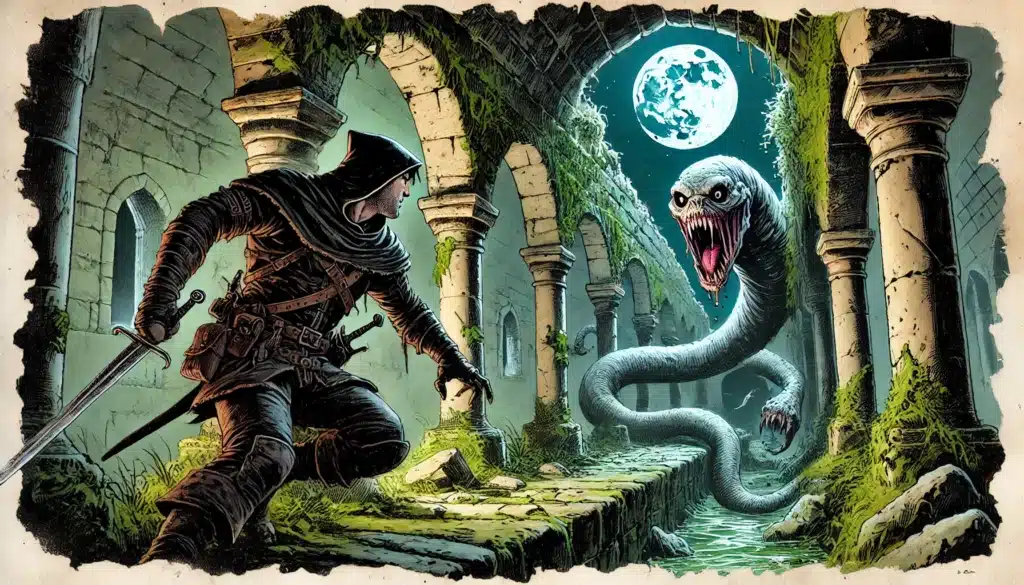
The Slow Unraveling: When Players Start to Remember
As players navigate the strange world of a False Hydra-infested town, the gradual unraveling of reality becomes a pivotal point in the campaign. This is where whispers turn to shouts, and the truth begins to claw its way to the surface. It’s essential to orchestrate this transition carefully, ensuring players feel the weight of revelation without handing them a tidy solution.
To reveal the Hydra’s influence effectively, Dungeon Masters must artfully craft moments of clarity amid the chaos. The key lies in presenting players with evidence that something is wrong, sparking a realization without dissolving the tension too quickly. These moments should be subtle, building on the foundation of doubt laid earlier, as players begin to see the cracks in their perceived reality.
Techniques for Making the False Hydra’s Influence Personal
- Forgotten Birthdays: NPCs or players reference past celebrations no one remembers.
- Backwards Clocks: Clocks tick counterclockwise, but everyone insists it’s normal.
- Vanishing Marks: Players discover scars or tattoos they can’t recall acquiring.
- Stranger’s Welcome: People greet players warmly, claiming past interactions that never happened.
- Unwritten Letters: Players find letters addressed to them with familiar handwriting.
- Mismatched Memories: Two players have contradicting memories of the same event.
- Phantom Pain: Players feel aches or phantom sensations linked to absent events.
- Inverted Paintings: Artwork depicts recognizable scenes eerily reversed.
- Reversed Roles: NPCs confuse players with others, misremembering roles or names.
- Silent Reflections: Reflections in water or mirrors lack sound or lag behind actions.
- Shadow Movements: Shadows align with someone unseen, out of sync with the world.
- Memory Gaps: Journals or diaries contain entries players don’t recall writing.
These techniques make the Hydra’s influence feel intimate and personal, weaving its way into everyday life in disconcerting ways. As players piece together these clues, the slow unraveling of reality motives them to dig deeper, questioning everything they hold dear.
The journey of discovery should be a gradual crescendo—an accumulation of evidence that leaves players with no other conclusion but the truth. But it’s crucial to maintain the tension, as this slow unraveling forms the heart of the psychological horror experience. Allow the paranoia to fester, doubts to bloom, and the dread to build into a palpable force.

Fantasy RPG AI Generators with ChatGPT+
Make life as a Game Master easier.... If you play Dungeon & Dragons, Pathfinder, or other fantasy tabletop role-playing games, check out my DND character backstory generator and other fine AI RPG tools at LitRPG Adventures Workshop today.
In the end, this slow unraveling isn’t merely about understanding what the Hydra has done, but grasping the full horror of its insidious influence. It’s about confronting the reality that everything they know could be a lie, carefully orchestrated to keep them in the dark. And it’s this realization that leads to the ultimate confrontation with the Hydra—a culmination of fear and revelation that challenges players to reclaim their world from within the jaws of illusion.
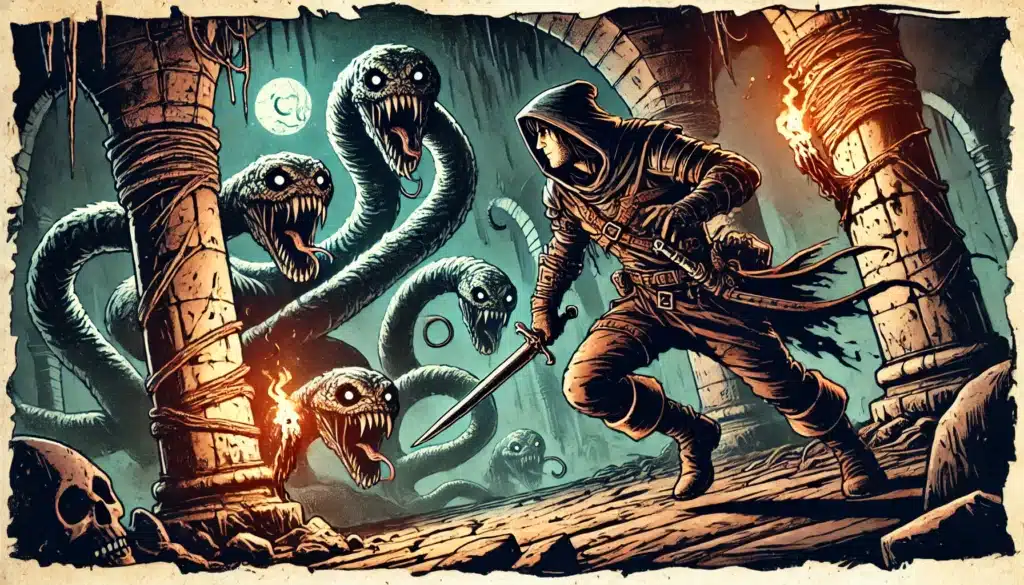
Running a False Hydra Encounter: Horror in Action
The moment has arrived. After piecing together the disturbing puzzle of vanishing people, fragmented realities, and warped memories, players are finally ready to confront the False Hydra. This isn’t merely about wielding weapons and spells; it’s about orchestrating a terrifying experience that encapsulates the full weight of the Hydra’s psychological horror.
For Dungeon Masters, the task is to ensure that this climactic encounter transcends a simple combat. The true terror of the Hydra lies not in its physical form but in the intangible fear it produces. Its presence should be felt before it’s seen, creating an atmosphere thick with tension and anticipation as players prepare to face the mind-bending entity.
The Hydra’s song—a haunting melody that warps perception and erases memories—is the lynchpin of its horror. As players venture into its lair, this song becomes an omnipresent force, an eerie soundtrack that keeps them on edge. It should weave through the encounter, warping recollections and altering reality in subtle, unnerving ways that challenge players’ grip on sanity.
Table: The Psychological Effects of the False Hydra’s Song
| Effect Description | Impact on Perception | Player Reaction |
|---|---|---|
| Forgotten Party Members | Players suddenly can’t recall a comrade | Paranoia and confusion |
| Echoes of Loved Ones | Hear disembodied voices of familiar people | Emotional turmoil |
| Misplaced Memories | Remember events differently than they occurred | Doubt and uncertainty |
| Rewritten History | Timeline of events seems altered | Disbelief and frustration |
| Phantom Footsteps | Hear footsteps with no visible source | Suspicion and apprehension |
| Vision Distortions | See things that aren’t there or space warps | Disorientation and fear |
| Flickering Shadows | Shadows appear alive or in wrong places | Increasing paranoia |
| Transient Reflections | Reflections seem to move of their own accord | Startling and unsettling |
| Inaudible Whispers | Hear whispers just out of understanding | Anxiety and dread |
| Emotional Confusion | Emotional responses feel manipulated | Emotional instability |
This haunting symphony is central to the conflict, ensuring the battle is as much about maintaining composure as it is about dealing damage. Before the fight begins, players should feel the oppressive weight of the lost memories, the gnawing realization of what’s been taken from them and the world.
The Hydra’s presence should be evident in every aspect of its lair—a tomb dedicated to forgotten souls. Players facing the creature should navigate an environment steeped in the echoes of its victims, with every room and corner telling a quiet story of those who vanished.
The final confrontation must blend narrative depth with strategic gameplay, ensuring the Hydra’s unique abilities come to the fore. Each attack, each spell, each maneuver should remind players of the delicate balance between reality and illusion, keeping them on a knife’s edge as they fight to reclaim their forgotten world.
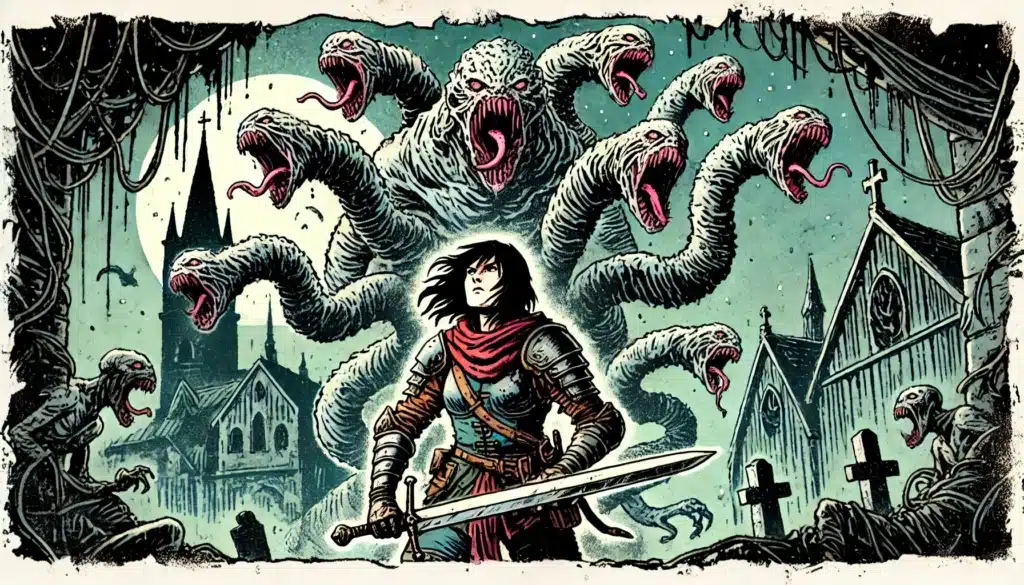
Designing a False Hydra Lair
The False Hydra’s lair is not merely its den; it’s a haunting tapestry woven with the memories of those it has consumed. This environment should feel like a living, breathing entity—a monument to its victims, echoing with the clamor of forgotten voices. Designing this space requires a keen eye for environmental storytelling, ensuring every corner holds a piece of the puzzle.
The lair should evoke a sense of dislocation and disorientation, with paths that twist upon themselves and rooms that defy logic. Players should question what they see and feel, as their minds grapple with the Hydra’s lingering influence. This setting becomes a narrative in itself, a place where reality bends beneath the weight of what’s been lost.
Unsettling Lair Features
- Remnants of Victims: Clothing, personal effects, or portraits of people players have no memory of.
- Reality Shifts: Rooms appear different each time they’re entered.
- Haunting Murals: Half-finished murals depict past events that never happened.
- Echoing Footfalls: The sound of footsteps in empty corridors that never seem to catch up.
- Disjointed Clocks: Clocks display time erratically, never in sync with each other.
- Dimensional Anomalies: Spaces where gravity feels altered or vision distorts.
- Vicarious Memories: Relics that trigger vivid but foreign memories in players.
- Wandering Shadows: Shadows behave independently of the light source.
- Broken Mirrors: Fractured reflections show scenes from forgotten moments.
- Lingering Scent: Unfamiliar smells evoke emotions or thoughts that don’t align with memory.
- Twisted Echoes: Unnatural echoes that repeat players’ voices in distorted tones.
- Ethereal Glow: A ghostly light that seems to emanate from nowhere and everywhere.
These features should create an environment where players feel the Hydra’s influence at every turn, a constant reminder of its powerful grasp over reality. As they explore, players should uncover the chilling consequences of its presence, piecing together the fragmented tales of those who fell to its song.
In essence, the lair serves as the final stage for confronting the Hydra—a place designed to unsettle and disorient, challenging players’ perceptions as they draw closer to the truth. It must resonate with the haunting echoes of the past, thrusting players into the heart of the narrative where all illusions converge.
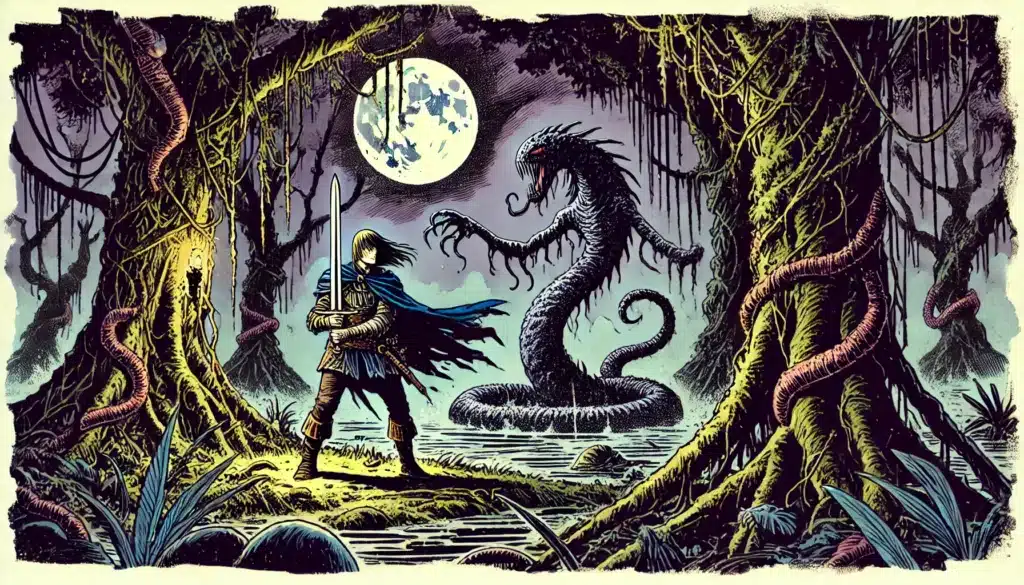
Combat with the False Hydra: Making It More Than Just a Fight
The battle with the False Hydra should feel like an intricate dance, one where players must contend with the Hydra’s unique abilities amidst the shifting tapestry of its reality. This encounter should transcend a simple test of strength, reflecting the psychological horror that defines the Hydra’s presence.
To ensure this battle remains true to the Hydra’s nature, it should incorporate mechanics that echo its themes of memory and perception. Players should find themselves questioning their actions, struggling against a foe that turns their own minds into weapons against them.
Unique Combat Mechanics
- Memory Lapses: Players forget who they are targeting mid-combat.
- Illusory Allies: The Hydra conjures visions of past allies to confuse players.
- Reality Flickers: The battle scene shifts, altering terrain or visibility.
- Echo of Voices: The Hydra summons voices of lost loved ones to distract.
- Memento Mori: Objects or attacks that trigger potent memories.
- Identity Crisis: Players must make saving throws to remember their roles.
- Repressed Memories: Hydra severs memories of certain spells or abilities.
- Adaptive Defense: The Hydra’s form shifts, making attacks miss.
- Remembrance Siphon: Players suffer psychic damage when recalling certain events.
- Resonant Cry: The Hydra’s wail causes players to relive traumatic memories.
- Time Slip: Actions seem to repeat or undo themselves.
- Perceptual Blur: Players’ vision distorts, impacting attack accuracy.
- Phantom Wounds: Illusory injuries that feel real.
- False Invulnerability: Illusions make the Hydra appear unaffected by damage.
- Resilient Deception: Regenerates based on players’ belief in its lies.
Each of these mechanics aims to immerse players in the Hydra’s intricate web of deception, making them question reality with every round. The encounter should feel like a battle within their own minds as much as a physical confrontation, an exercise in perceiving truth amid the Hydra’s lies.
The horror elements should remain intact throughout, using these mechanics to enhance the psychological impact of the encounter. It’s not just about defeating a monster; it’s about reclaiming the world from the Hydra’s grasp, shattering the illusions that held players captive.
In this tense, climactic showdown, the lines between reality and perception blur, challenging players to rely on their wits and experiences. Here, the true battle is not just for victory, but for memory and identity, making the False Hydra an unforgettable adversary in the grand tapestry of Dungeons and Dragons.
Try my AI Tabletop RPG generators...and an extensive library of content!
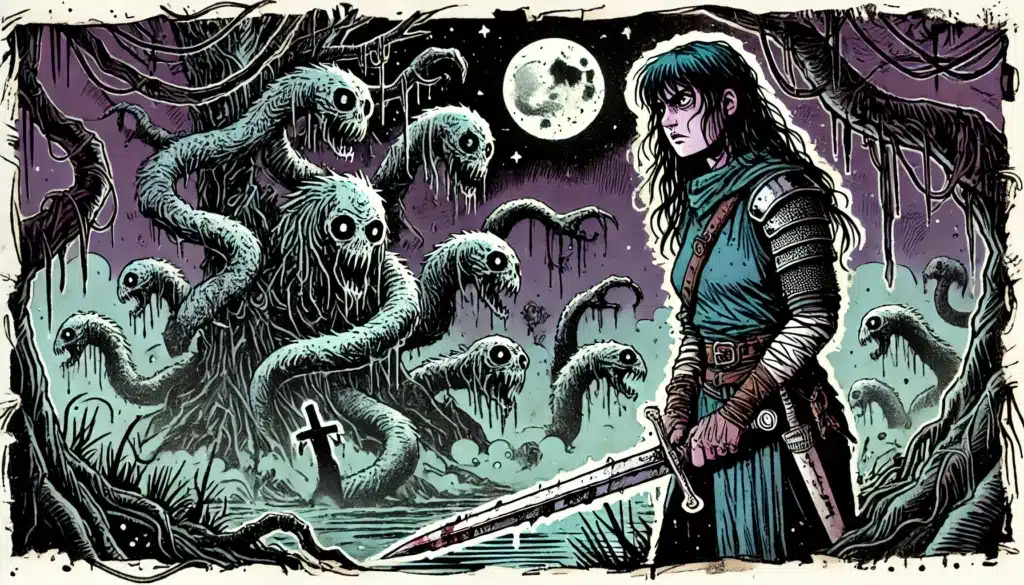
Aftermath: How to Handle the Psychological Fallout
When the False Hydra’s influence is finally shattered, the world it held captive begins to heal—yet for those who survived, the scars run deep. The Hydra’s defeat doesn’t erase the memories of its existence; instead, it leaves behind a fractured reality, one that must be painstakingly rebuilt. The psychological aftermath of such an encounter can be profound, affecting both players and NPCs as they grapple with the remnants of forgotten time.
Rebuilding this world requires an understanding of the Hydra’s impact on the collective consciousness—the gaps in memory, the lingering traces of vanished faces, the dissonance between reality and illusion. It’s a chance for characters to reflect, to mourn, and, ultimately, to find closure in the wake of chaos.
The Hydra’s song might be silenced, but its echoes remain—ambient whispers that remind survivors of what they’ve lost. For some, the return to normalcy can be a painful process, each remembered victim a reminder of the fragility and impermanence of existence.
Coping with Forgotten Victims and Lost Time
- Guilt-ridden Characters: Characters may feel responsible for not realizing the Hydra’s deception sooner.
- Grief and Mourning: NPCs mourn loved ones they forgot, grappling with the guilt of their absence.
- Community Rebuilding: Townsfolk work to restore the fractured community, rebuilding connections.
- Personal Reflection: Characters embark on personal quests to reconcile lost memories.
- Celebration of Remembrance: Ceremonies held to honor those lost and newly remembered.
- Conflicting Memories: Characters struggle with conflicting versions of past events.
- Emotional Turmoil: Characters experience intense emotions from returned memories.
- Lost Friendships: Bonds broken by missing people struggle to reform.
- Desire for Understanding: Characters seek out information about the Hydra to comprehend its motives.
- Improvised Rituals: Communities perform rituals to cleanse lingering Hydra influences.
- Permanent Amnesia: Some victims remain forever forgotten, leaving unresolved questions.
- Support Networks: Individuals form groups to support each other through the emotional aftermath.
- Resilience and Growth: Characters grow stronger from the ordeal, with a new understanding of reality.
- Revised Histories: Town records are painstakingly updated to reflect true histories.
- Haunted Dreams: Survivors are plagued by dreams of what was lost, struggling to find peace.
These avenues of exploration provide depth to the aftermath, emphasizing that the journey doesn’t end with the Hydra’s fall. The psychological impact of the encounter extends beyond the physical realm, prompting characters to confront their own sense of identity and purpose in the face of unsettling truths.
The aftermath of a False Hydra campaign is not merely a denouement but an integral part of the story, offering a rich tapestry of narrative possibilities. It challenges players to reckon with the fragile nature of memory and the resilience of the human spirit. As the world they know begins to settle, players are left with a poignant reminder of what it means to remember and to forget.

Fantasy RPG AI Generators with ChatGPT+
Make life as a Game Master easier.... If you play Dungeon & Dragons, Pathfinder, or other fantasy tabletop role-playing games, check out my DND character backstory generator and other fine AI RPG tools at LitRPG Adventures Workshop today.
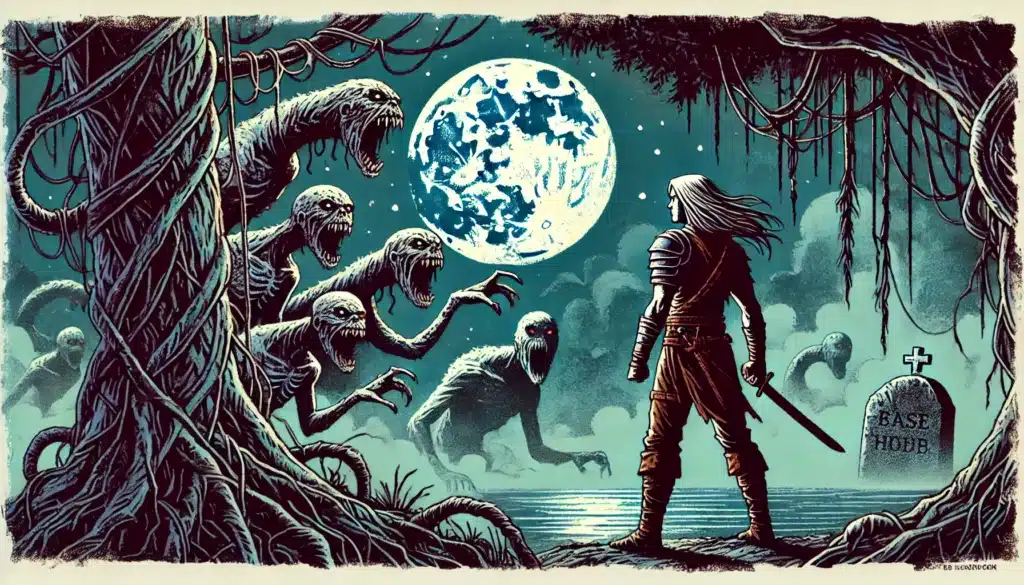
Alternative Endings: What If the False Hydra Wins?
In the realm of storytelling, not every tale ends with victory. Sometimes, the Hydra’s song proves too powerful, its influence too deeply rooted in the fabric of reality. Should the players fail—whether by surrendering to the song, falling in battle, or abandoning the town without uncovering the truth—the campaign doesn’t have to end. Instead, it opens the door to a darker chapter, offering opportunities for redemption and richer storytelling.
When the Hydra triumphs, the world falls further into the shadow of forgetfulness. Its song rings louder, erasing more memories until the town becomes a hollow shell, a tableau of mundane life amidst unseen horrors. The players might be gone, but their absence leaves a mark—a wrongness that begs to be righted.
Table: Failed Campaign Endings
| Ending Description | Consequences | Redemption Arc |
|---|---|---|
| Whole Town Forgotten | Town vanishes from maps and minds | New adventurers uncover the truth |
| Players Become NPCs | They live new lives, unaware of past | An ally breaks free and seeks them |
| Perpetual Loop | Reality resets, players relive events | Discovering the loop’s secret |
| Hydra Ascendance | Hydra spreads its influence further | Heroes return with newfound strength |
| Shattered Timeline | Time fractures, events play out differently | Rebuilding a coherent timeline |
| Reality Rift | Opens a portal to parallel realities | Closing the rift to restore balance |
| Diminishing Returns | Each failure weakens the players’ resolve | A mentor’s guidance |
| Memory Devourer | Hydra grows stronger with each defeat | A forgotten ally returns |
| Enslaved Willingly | Players come to serve the Hydra | Realization and rebellion |
| Town in Stasis | Time freezes around the town | An artifact restores flow |
These possible endings present a canvas for further exploration, offering players a chance to pursue redemption and resolution. Even in defeat, the bonds formed through shared struggle can serve as a foundation for renewal. The darkness can be an impetus for growth, forging new paths and new beginnings away from the Hydra’s song.
The allure of a False Hydra’s victory lies in its potential to reshape the campaign’s future, allowing new characters or settings to rise from the ashes. The world might have shifted, but the core essence of adventure—discovery, growth, and understanding—remains. The story doesn’t end; it simply evolves, enriched by the trials faced and the lessons learned.
In this way, a False Hydra victory is not a finale, but a transformation. It challenges players and Dungeon Masters alike to adapt, innovate, and find meaning in the shadows. The Hydra may have won the battle, but the war for reality is far from over, leaving ample room for stories yet untold and memories waiting to be reclaimed.
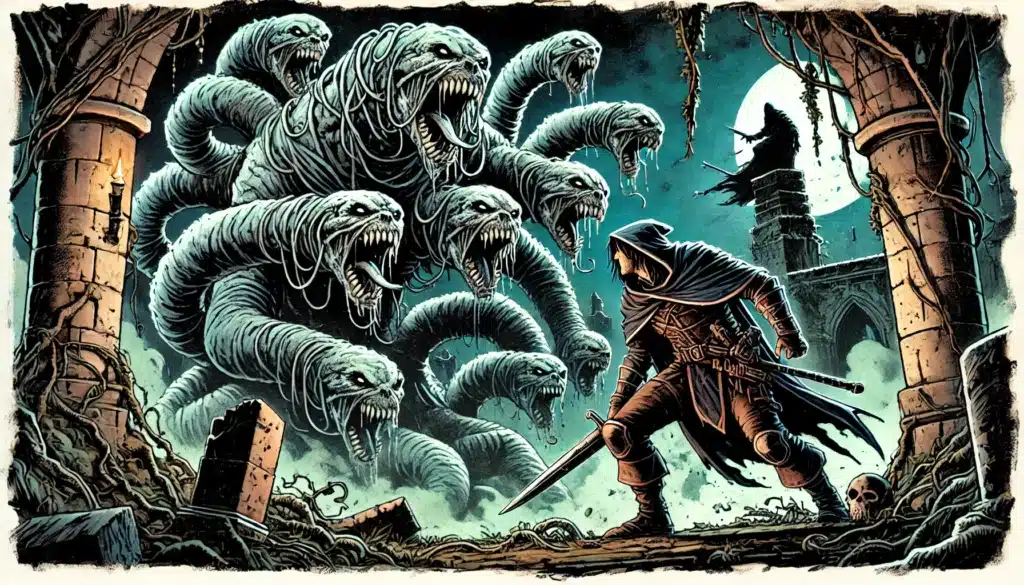
Final Thoughts on Using the False Hydra in a D&D Campaign
In conclusion, the False Hydra stands as one of the most enigmatic and terrifying creatures a Dungeon Master can introduce into a Dungeons & Dragons campaign. It’s not just about its monstrous form or the eerie power it wields; it’s about the psychological horror it embodies—erasing not just people but the very memory of them, leaving a palpable void in reality itself. This monster is a narrative force, demanding a meticulous approach that weaves together subtle horror techniques with compelling storytelling.
The true mastery of using the False Hydra lies in leveraging its ability to manipulate perception and identity. By doing so, Dungeon Masters can create a campaign that is as much a mystery as it is an adventure, prompting players to question not only the world around them but also their own memories and relationships. The encounter becomes a nuanced exploration of fear and doubt, engaging players in a dance of perception that is both thrilling and unsettling.
Encourage Dungeon Masters to experiment with these subtle techniques, focusing on player perception and crafting a narrative that challenges the very fabric of their characters’ reality. This is not merely a battle to be won with strength and skill; it is a test of wits, will, and wisdom, requiring players to step beyond the familiar confines of the game and into a world where memory itself is mutable.
The allure of the False Hydra is its capacity to transform a standard campaign into an exploration of identity and memory, where the ultimate enemy isn’t just the creature itself but the fear of forgetting—of being forgotten. It’s an embodiment of existential dread, a reminder of the delicate and ephemeral nature of reality.
Dungeon Masters are invited to delve into this rich tapestry of horror and intrigue, to shift the focus from a simple monster fight to a story of shadows and whispers that lingers long after the game has ended. Remember, the true horror of the False Hydra isn’t just that it erases people; it’s the unsettling reality that everyone else moves on as if they never existed. It’s a chilling reminder of the power of memory and the ultimate quest to reclaim what has been lost.
In this dance of shadows and memory, the Hydra becomes more than a monster—it becomes a catalyst for one of the most hauntingly complex stories a D&D campaign can tell. So, take up the challenge, embrace the mystery, and let the echoes of forgotten songs guide your game into realms uncharted and unforgettable.

